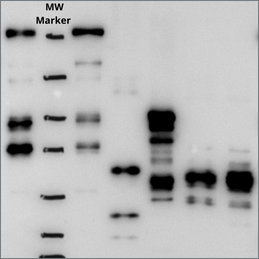Nov 17, 2023

Western blots are a ubiquitous technique used in research labs to study proteins of interest. Western blotting is used for antibody validation, protein-protein interaction studies, and many other applications.1 However, generating interpretable western blot results can be challenging. Below are some commonly encountered issues and how to resolve them.2
 High Background High Background
|
| Could be caused by |
Try this |
| High antibody concentration | Set up a titration with both the primary and secondary antibody. Include a known protein control. |
| Blocking solution | Use fresh blocking solution, increase blocking time/temperature, try different blocking agents. |
| Blot dried out during blocking/washes | Ensure membrane is adequately covered during blocking and wash steps. |
| Not enough washes | Increase the number of washes and the volume of wash solution. Ensure a minimum of 3 washes of 5 min each. |
| Over-exposure of film | Try a shorter exposure. |
 No Signal No Signal
|
| Could be caused by |
Try this |
| Antibody concentration too low | Set up a titration with both the primary and secondary antibody. Include a known protein control. |
| Low amounts of target in sample | Increase protein concentration on gel. Titration is recommended. |
| Primary and secondary antibody mismatch | Ensure secondary antibody is against the host species that the primary was raised in. |
| Problems with transfer | Use protein markers with color to check transfer. Optimize transfer using control protein. Check for air bubbles before transfer. |
| Too many washes | Reduce number of washes. |
 Multiple Bands Multiple Bands
|
| Could be caused by |
Try this |
| Gel overloaded | Titrate protein samples loaded on gel. |
| Too much antibody used | Set up a titration with both the primary and secondary antibody. Include a known protein control. |
| Over-exposure of film | Try a shorter exposure. |
| Issues with blocking | Use fresh blocking solution, increase blocking time/temperature, try different blocking agent. |
| Post-translational modification of target protein | Research published examples of post-translational modifications of target protein which could provide a biological explanation (i.e., phosphorylation, glycosylation, ribosylation). |
| Post-translation cleavage | Many proteins are synthesized as pro-proteins and then cleaved to give the active form, e.g. pro-caspases. Research published examples for your target. |
| Splice variants | Alternative splicing may create different sized proteins produced from the same gene. Research published examples for your target. |
OriGene solutions for western blotting:
For questions, contact Technical Support at techsupport@origene.com
References
- https://www.technologynetworks.com/analysis/articles/western-blot-procedures-analysis-and-purpose-353918
- https://www.news-medical.net/whitepaper/20200128/A-Guide-to-Solving-Western-Blot-Protocol-Issues.aspx































































































































































































































































 Germany
Germany
 Japan
Japan
 United Kingdom
United Kingdom
 China
China


